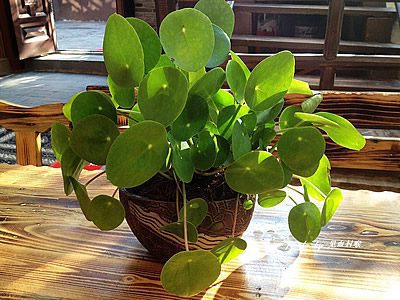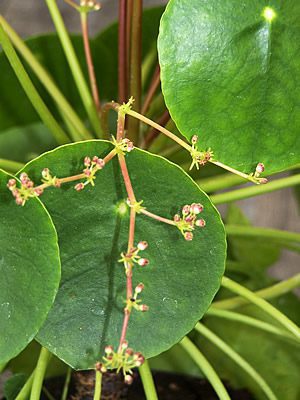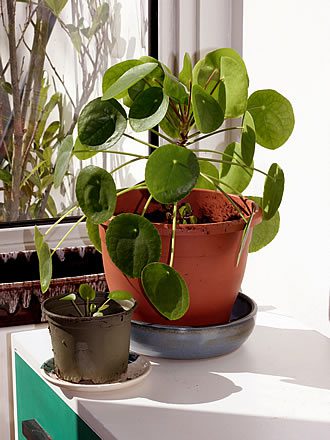The Chinese Money Plant (Pilea peperomioides) is an ornamental foliage, native to the provinces of Yunnan and Sichuan in southern China, where it grows on moist rocks in forests between 4921 to 9843 feet (1500 and 3000m) in altitude. Recently discovered, it was first collected in 1906 by George Forrest. However, it was not properly recorded and fell into oblivion. In 1945, Norwegian missionary Agnar Espegren rediscovered it, collected plants, and was responsible for its introduction in Scandinavia, where it became a very popular indoor plant. Despite its success in the Nordic countries, it was only formally described and classified in the 1980s. Today, it is a highly successful ornamental plant not only in Sweden, Denmark, and Norway, but worldwide.

It resembles a peperomia (Peperomia polybrotya) and reaches about 32 inches (80 cm) in height. Its stem is erect and the texture succulent, slightly lignifying at the base in older specimens. The leaves are peltate (the petiole attaches in the middle of the blade), round, bright green in color with long petioles. Each leaf can reach 5.9 inches (15 cm) in diameter, although they usually do not exceed 2.75 inches (7 cm). If grown under less than ideal conditions, it sheds its lower leaves, acquiring an interesting appearance, like a small tree. The flowers are of little ornamental importance.
The Friendship Plant, as it is also known, is an exotic and beautiful foliage to cultivate potted in indoor environments. It is already considered an icon of the avant-garde Urban Jungle, rivaling in popularity with Monsteras and Begonias, among other stars of this movement. Protected in homes or greenhouses, it can be grown anywhere, from the cold Scandinavian countries to the tropics. It’s also perfect for planting in closed terrariums, as it appreciates warmth and humidity. It’s a symbol of friendship, and it’s a great honor to receive a specimen as a gift.
Easy to handle, it does not require regular pruning or interventions. However, older plants may need support to keep the stem upright, as the aerial part can become somewhat heavy for the herbaceous stem. For this, get a metal or wooden stake and place it in the soil, parallel to the plant. Gently attach the stem of the Chinese Money Plant with clips. Take care of the plant’s symmetry, rotating the pot every day so that it grows evenly and does not lose leaves on one side.

It should be cultivated under diffused light or partial shade, in fertile, drainable soil, enriched with organic matter and watered at regular intervals, allowing the substrate to dry between watering. It appreciates intense indirect light and can receive direct sunlight in the early morning or late afternoon. It does not tolerate cold or frost and needs temperatures above 50°F (10°C). Similarly, intense heat and very dry environments are harmful.
Increase the frequency of water sprays in summer, and move the plant to a cooler but wind-protected location if necessary. Reduce watering in winter and avoid waterlogging, which can cause root rot. Fertilize every 3 months with slow-release fertilizer, like Osmocote. During the growing season, apply liquid fertilizers every 15 days for optimal development and large, shiny, healthy leaves. It propagates easily through stem cuttings from the main stem and separation of the shoots formed at the base of the mother plant.


